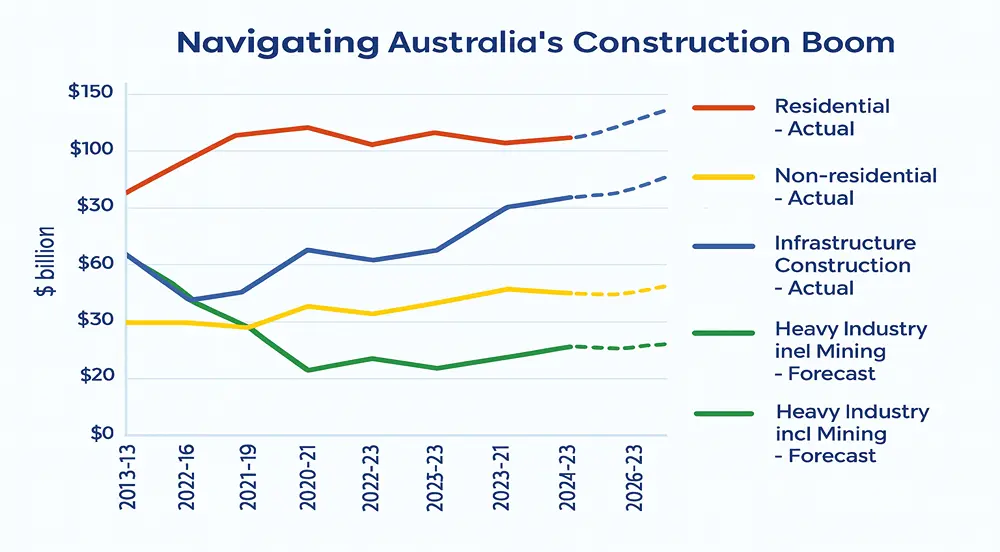Navigating Australia’s Construction Boom requires strategic planning amid record infrastructure investments exceeding AUD 300 billion by 2025. With rising labor shortages, material cost fluctuations, and sustainability mandates, builders must embrace digital estimating tools and modular construction methods to stay competitive and deliver on Australia’s growing urban development demands.
Where the Growth Is Happening?
Australia’s construction sector is expanding rapidly, driven by surging demand for housing, infrastructure, and commercial development. Emerging opportunities are concentrated in urban growth corridors and renewable energy projects, reflecting strong investor confidence and government-backed initiatives.
According to the Australian Construction Industry Forum (ACIF), construction activity will reach $334 billion in 2024–25, growing by 1.6%, with further growth of 1.9% expected in 2025–26 as lower interest rates boost demand.Latest Summary – Australian Construction Industry Forum
Residential and High-Density Housing
Australia’s population growth, particularly in cities like Sydney, Melbourne, and Brisbane, fuels demand for residential construction. High-density housing, such as apartment complexes, is surging to accommodate urban dwellers. For instance, Sydney alone has seen over 250 residential cranes dotting its skyline in recent years. Developers must balance quality and affordability to meet this demand effectively.
Engineering and Major Infrastructure Works
Government-led infrastructure spending is a cornerstone of the boom. In New South Wales, $73 billion is allocated over four years for projects like motorways and rail expansions. These initiatives aim to enhance connectivity and support urban growth. Contractors need precise estimating to secure bids and deliver projects on time and within budget.
Commercial and Industrial Developments
Commercial projects, including office towers and retail hubs, are expanding alongside industrial facilities like warehouses. The rise of e-commerce has spurred demand for logistics centres, particularly in outer metropolitan areas. Businesses must align their strategies with these trends to tap into this lucrative market segment.
Key Challenges of Navigating the Boom
While opportunities abound, the construction boom presents significant hurdles. Addressing these challenges requires strategic foresight and adaptability.
Rising Material Costs and Supply Chain Disruptions
Material costs have skyrocketed, with steel and timber prices rising by up to 30% in some regions since 2020. Global supply chain disruptions, exacerbated by geopolitical tensions, have delayed deliveries. Companies must diversify suppliers and leverage technology for accurate cost forecasting to mitigate these risks.
Labour Shortages and Skills Gaps
The industry faces a critical shortage of skilled workers. Reports indicate Australia has 50% more construction workers per capita than the U.S., yet demand outstrips supply. Training programs and immigration policies are vital to bridge this gap, ensuring projects stay on schedule.
Regulatory and Approval Complexities
Navigating Australia’s regulatory landscape can be daunting. Delays in approvals for major projects can extend timelines by months. Streamlining compliance processes and engaging with local authorities early can help firms avoid costly setbacks.
Opportunities Emerging for Stakeholders
The construction boom offers a wealth of possibilities for those ready to act decisively. From investment to global collaboration, stakeholders can position themselves for success.
Investment Opportunities in Residential and Infrastructure
The residential and infrastructure sectors are ripe for investment. Private developers can partner with government initiatives to fund housing projects, while infrastructure bonds offer stable returns. For example, the $14.4 billion NSW budget for 2018 sparked a wave of private-sector involvement.
Career Growth and Skilled Workforce Demand
The demand for skilled professionals, from estimators to project managers, is soaring. Training institutes report a 20% increase in enrolments for construction-related courses. Career seekers can capitalise on this by upskilling in areas like cost estimation or sustainable building practices.
Offshore Partnerships and Global Collaboration
Partnering with offshore construction companies can bring expertise and resources to complex projects. These collaborations enable knowledge transfer and access to innovative technologies, such as modular construction, which can reduce costs by up to 15%. Choosing the right offshore partner is critical to ensure alignment with local standards and project goals.
Exporting Australian Expertise and Innovation
Australia’s reputation for quality construction opens doors to export expertise. Firms specialising in sustainable design or advanced estimating techniques are in demand globally. For instance, Australian companies have secured contracts in Southeast Asia, leveraging their robust methodologies.
Strategic Playbook for Businesses
To thrive in this dynamic environment, businesses must adopt a proactive approach. Here’s a concise strategy to navigate the boom effectively:
-
Invest in Technology; Use Building Information Modelling (BIM) and estimating software to enhance accuracy and efficiency.
-
Build Strong Networks; Collaborate with local and international partners to share resources and expertise.
-
Prioritise Sustainability; Incorporate eco-friendly materials and practices to meet regulatory and market demands.
-
Upskill Teams; Invest in training to address skills shortages and boost project delivery.
|
Strategy |
Benefit |
Example |
|---|---|---|
|
Technology Adoption |
Improves cost accuracy and project timelines |
Using BIM to reduce errors by 20% |
|
Strategic Partnerships |
Enhances resource availability |
Collaborating with offshore firms for modular builds |
|
Sustainability Focus |
Meets regulatory standards |
Using recycled materials to cut costs |
|
Workforce Training |
Addresses labour shortages |
Certifying estimators in advanced software |
Future Outlook for Australia’s Construction Industry
The construction boom shows no signs of slowing. With urbanisation projected to increase by 1.6% annually and government spending locked in, opportunities will persist. However, businesses must stay agile, addressing material cost volatility and labour challenges. Embracing digital tools and global partnerships will be key to sustaining growth and delivering value in this vibrant sector.


